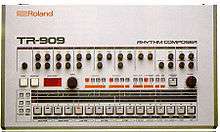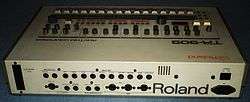Roland TR-909
The Roland TR-909 Rhythm Composer is a drum machine introduced by the Roland Corporation in 1983. It succeeded the TR-808, and was the first Roland drum machine to use samples and MIDI. Though it was a commercial failure, the 909 became influential in the development of electronic dance music such as techno, house and acid.
| TR-909 | |
|---|---|
 TR-909 Front Panel | |
| Manufacturer | Roland |
| Dates | 1983–1985 |
| Price | $1,195 USD £999 GBP ¥189,000 JPY |
| Technical specifications | |
| Polyphony | 12 voices |
| Timbrality | none |
| Synthesis type | Analog Subtractive and Digital Sample-based Subtractive |
| Aftertouch expression | No |
| Velocity expression | Yes |
| Storage memory | 96 Patterns, 8 Songs |
| Effects | Individual level, tuning, attack, decay, and tone controls for some sounds |
| Input/output | |
| Keyboard | 16 Pattern Keys |
| External control | MIDI In/Out & DIN Sync In |
Design
The 909 was designed by Tadao Kikumoto, who also designed the Roland TB-303 synthesizer.[1] Chief Roland engineer Makoto Muroi credited the design of the analog and pulse-code modulation voice circuits to "Mr Ou" and its software to "Mr Hoshiai".[2]
Sounds and features

Whereas its predecessor, the TR-808, is known for its "boomy" bass, the 909 sounds aggressive and "punchy".[3][4] It was the first Roland drum machine to use samples (prerecorded sounds), for its crash, ride and hi-hat sounds; other sounds are generated with analog synthesis.[5] As the clap and snare are generated via the same noise source, they produce a phasing effect when played together.[6]
The 909 was also the first Roland drum machine to use MIDI,[2] allowing it to synchronize with other devices,[5] or for sounds to be triggered by an external MIDI controller for wider dynamic range.[2] Older Roland machines can be synchronized via its DIN sync port (a precursor to MIDI).[2]
The 909 features a sequencer that can chain up to 96 patterns into songs of up to 896 measures, and controls including shuffle and flam.[5] It features an improved accent feature, allowing users to accent particular beats or sounds.[2]
Roland changed elements of the 909 during its lifetime, correcting problems and adjusting sounds. Some users modify their machines to match sounds from earlier revisions.[6]
Release
The 909 was released in 1983[5] and retailed for $1,195 USD.[5] According to Muroi, it was a commercial failure as users preferred the more realistic sampled sounds of competing products such as the LinnDrum.[2] Roland ceased production after one year,[2] having built 10,000 units.[7] It was replaced in 1984 by the TR-707, which uses samples for all its sounds.[2]
Legacy
Whereas the TR-808 was important in the development of hip hop, the 909, alongside the 303 synthesizer, influenced dance music such as techno, house and acid.[8][9] According to Gordon Reid of Sound on Sound, "Like the TR-808 before it, nobody could have predicted the reverence in which the TR-909 would eventually come to be held."[5]
The first known commercial use of a 909 is on the album Remission by Skinny Puppy, released months after the 909 launch.[5] It was popularized in the late 1980s by producers in Chicago and Detroit such as Derrick May, Frankie Knuckles and Jeff Mills, who bought second-hand units.[3] As the first Roland drum machine to use MIDI, producers used the 909 as a hub to synchronize and sequence other machines, which Roland had not anticipated.[5] The Icelandic singer Björk used it to create "militaristic" percussion on her 1997 song "Hunter".[10]
In 2017, Roland released the TR-09, a miniature version of the 909 with additional features.[6]
References
- Hsieh, Christine. "Electronic Musician: Tadao Kikumoto". Retrieved 2010-10-02.
- Kirn, Peter (2011). Keyboard presents the evolution of electronic dance music. Backbeat Books. ISBN 978-1-61713-446-3.
- "Listen to an exclusive playlist of TR-909 classics". FACT Magazine: Music News, New Music. 2016-09-09. Retrieved 2018-04-10.
- "Nine Great Tracks That Use the Roland TR-909Orbital - "Chime"". Complex. Retrieved 2018-04-10.
- Reid, Gordon (December 2014). "The history of Roland: part 2 | Sound On Sound". Sound on Sound. Retrieved 3 January 2016.
- "Roland TR-09 Rhythm Composer review". MusicRadar. Retrieved 2018-04-25.
- Butler, Mark Jonathan. "Unlocking the Groove: Rhythm, Meter, and Musical Design in Electronic Dance Music". Indiana University Press, 2006. ISBN 0-2533-4662-2. p. 64
- "Nine Great Tracks That Use the Roland TR-909". Complex. Retrieved 2018-03-26.
- "9 of the best 909 tracks using the TR-909". Mixmag. Retrieved 2018-03-26.
- Pytlik, Mark (2003). Bjork: Wow and Flutter. ECW Press. pp. 180–181. ISBN 978-1550225563. Retrieved 7 November 2014.
Further reading
- "Roland TR-909". Electronics & Music Maker. March 1984. p. 38. OCLC 317187644.